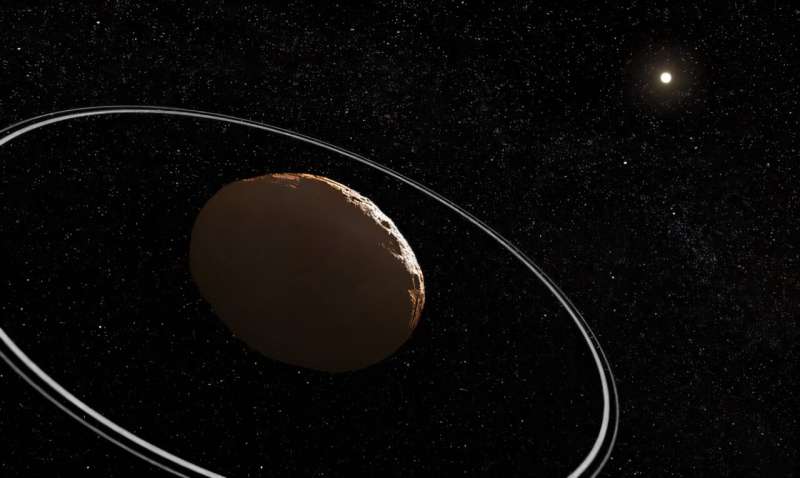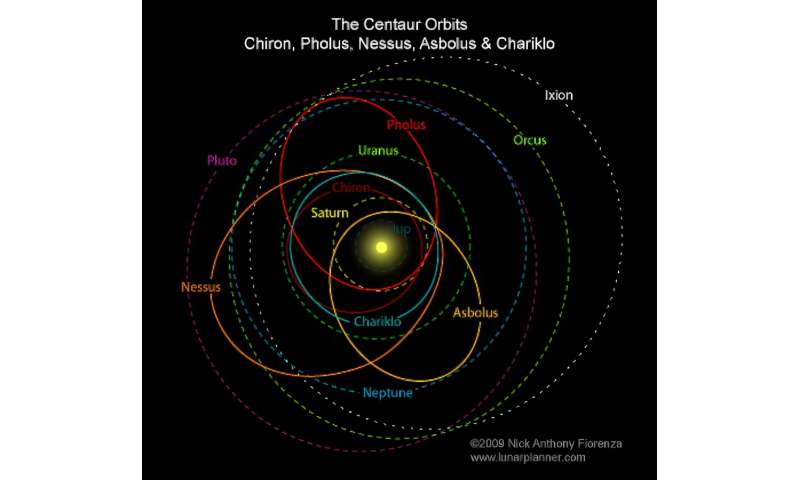You might have seen an interesting phrase popping up in your social media feeds lately: “Chiron is in retrograde.” If you’re anything like me, you’ve never heard of Chiron before—and I’m a professional astronomer.
So what is Chiron, and what does it mean to be in retrograde? The short answer is that Chiron is an asteroid-slash-comet orbiting somewhere past Jupiter and Saturn. And until January 2026, it’s going to look like it’s going backwards in the sky. If you can spot it.
But there’s a bit more to the story.
What is Chiron?
Chiron’s official name is (2060) Chiron. First things first: it’s pronounced “kai-ruhn,” with a hard K sound.
It was discovered by astronomer Charles Kowal in 1977. This was long after the system of Western astrology was developed, which probably explains why people who check their daily horoscopes are also blissfully unaware of its existence.
It was initially classified as an asteroid, or a rock in space. In 1989, astronomers discovered Chiron sometimes has a tail or “coma,” which tells us that it’s actually a comet or a “dirty snowball.” Since then, Chiron has been classified as both an asteroid and a comet.
In 2023, more than 45 years after it was first discovered, astronomers confirmed Chiron has rings. This makes it the fourth non-planet in the solar system to have rings. (The planets Jupiter, Saturn, Uranus and Neptune have rings, as do the asteroid Chariklo and the dwarf planets Haumea and Quaoar.)
Chiron orbits the sun in an oval-shaped orbit. The closest it gets to the sun is about 1.3 billion kilometers (about eight times the distance between Earth and the sun) and the furthest it gets from the sun is a whopping 2.7 billion km (about 19 times the distance between Earth and the sun).
This puts it between the orbits of Jupiter and Uranus, cutting through the orbit of Saturn.
Centaurs in space
Chiron is a member of the Centaurs. This is a group of small solar system bodies that orbit the sun between Jupiter and Neptune. Their orbits are highly unstable: they change over time because of gravitational interactions with the giant planets.
In Greek mythology, centaurs were creatures with the lower body and legs of a horse and the torso and arms of a human. Chiron was the oldest centaur, the son of the Titan Kronos. He was considered the wisest centaur.
Fans of Percy Jackson and the Olympians may also recognize Chiron as the director of Camp Halfblood.

Artist’s impression of the Centaur asteroid 10199 Chariklo. Chariklo was the first asteroid and fifth object in our solar system, after Saturn, Jupiter, Uranus and Neptune, found to have a ring around it. Credit: NASA, ESA, CSA, Leah Hustak (STScI), CC BY-SA
Chiron in retrograde
In astronomy, retrograde motion is when something is going backwards compared with everything else.
Apparent retrograde motion is where an object in the sky, such as a planet, appears to be going backwards when we look at it from Earth. The object hasn’t actually changed direction; it just looks like it from our perspective.
Discover the latest in science, tech, and space with over 100,000 subscribers who rely on Phys.org for daily insights.
Sign up for our free newsletter and get updates on breakthroughs,
innovations, and research that matter—daily or weekly.
All the planets (and Chiron) orbit the sun in the same direction. This means the planets typically look like they are moving in a west-to-east direction across the sky. But when Earth “catches” up to a planet (or a planet catches up to Earth) and overtakes it, the planet temporarily appears to move in a west-to-east direction in the sky.
This temporary illusion is apparent retrograde motion. It’s just like when you’re driving in a car and overtake a slower car, that slower car looks like it’s going backwards as you overtake it.
-

The orbits of various centaurs, including Chiron. We can see the orbits of Jupiter, Saturn, Uranus and Neptune as well of the orbits of various small solar system bodies and dwarf planets. Credit: Nick Anthony Fiorenza, CC BY-SA
-

Animation demonstrating apparent retrograde motion. We can see the Earth and an outer planet orbiting the Sun in a circular motion on the left. On the right, we can see the direction the planet appears to be moving from Earth’s perspective. Credit: Dominic Ford, CC BY-SA
Chiron went into retrograde (that is, apparent retrograde motion) on July 30, 2025 and will go back to normal on January 2, 2026. But unless you have a telescope or do some long-exposure photography, you’d never know which way Chiron is traveling. Chiron is very faint, so you can’t see it with your eyes.
The ancient astrologers didn’t know about Chiron, but I like to think they’d appreciate a centaur in space with a ring on it.
Provided by
The Conversation
This article is republished from The Conversation under a Creative Commons license. Read the original article.![]()
Citation:
Move over Mercury—Chiron is in retrograde: What even is Chiron? (2025, August 8)
retrieved 9 August 2025
from https://phys.org/news/2025-08-mercury-chiron-retrograde.html
This document is subject to copyright. Apart from any fair dealing for the purpose of private study or research, no
part may be reproduced without the written permission. The content is provided for information purposes only.
